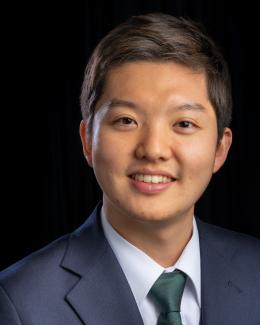JungHyun Bae, ORNL Wigner Fellow, is building a muon device to help safeguard nuclear material. Credit: Genevieve Martin/ORNL, U.S. Dept. of Energy
JungHyun Bae is a nuclear scientist studying applications of particles that have some beneficial properties: They are everywhere, they are unlimited, they are safe.
They are cosmic ray muons, one of the fundamental particles in the Standard Model of the universe. Bae, a Eugene P. Wigner Fellow at the Department of Energy’s Oak Ridge National Laboratory, is studying ways to detect cosmic ray muons and measure their momentum in the field. Measuring momentum and deflection angle of this fundamental particle is important because they provide scientists the ability to monitor dense and large objects, such as spent nuclear fuel dry storage canisters, nuclear reactor cores or even the chambers holding magma beneath volcanoes.
This nondestructive radiography technology is called muon tomography. It is similar to the more familiar X-ray technology, but while X-rays in a hospital work well on a human body, muons are better for imaging large objects like uranium nuclear fuel assemblies.
“It is important to improve the utility of cosmic ray muons in muon tomography because their wide application is often limited due to their naturally low flux. The expected number of muon particles at sea level is only approximately 10,000 per square meter in a minute,” Bae said.
The muons that hit the Earth result from particles in the Earth’s atmosphere colliding with cosmic rays emanating from the sun — high-energy protons and atomic nuclei that move through space at almost the speed of light. Cosmic ray muons exist for only 2.2 microseconds before they decay but reach every square inch of Earth, passing through everyone and everything before they do.
Through his doctoral dissertation in nuclear engineering at Purdue University, Bae described a new proof-of-concept muon spectrometer and tomography system to advance the use of muons in applications including nuclear engineering. One example is monitoring spent nuclear fuel storage canisters.
“Using the muon momentum and deflection, we can build highly efficient high-resolution images of the fuel rods stored in spent nuclear fuel casks,” Bae said. “The muons are a promising unconventional highly energetic radiation probe capable of passing though the very dense casks that cannot be imaged in any other way.” He used computer simulations to design the new muon momentum detector and advanced tomography system that will be developed to monitor spent nuclear fuel and radioactive materials in interim storage and disposal conditions.
“I focus on how to manage and monitor used nuclear fuel safely and efficiently. This is a nationwide challenge, and our group research will address those kinds of challenges. It would be beneficial for the nation and even better for the world,” he said.
Now working in the Used Fuel and Nuclear Material Disposition, or UFNMD, group in the Nuclear Energy and Fuel Cycle Division at ORNL, Bae is building an experimental apparatus to test his theories in collaboration with the SNS Detector Group. The prototypical Cherenkov muon spectrometer and momentum integrated muon tomography system will be tested using surrogate fuel assemblies in a spent fuel canister on the ORNL campus. Mentored by Rose Montgomery, distinguished research staff and UFNMD group leader, Bae is interested in nuclear security and nuclear material management. “Now I am working on design of an experiment to test my theory,” he said.
Bae graduated college from the Korea Advanced Institute of Science and Technology in Daejeon, South Korea, and he received a master’s degree at the University of California, Berkeley. While in graduate school, Bae attended a seminar by then-ORNL UFNMD researcher Stylianos Chatzidakis, also a Purdue alumnus and past ORNL Weinberg Fellow who now is director of the Nuclear Engineering Radiation Laboratory at Purdue. He became Bae’s advisor and steered Bae to the ORNL Fellowship program.
Science and engineering are in Bae’s blood. His father worked in the nuclear industry for more than 40 years and his mother is an architect who designs homes and buildings.
“I learned the necessity of nuclear energy and the beauty of science from them,” Bae said.
Education and community engagement are critically important to him, Bae said, and he is involved in ORNL’s educational outreach activities as a result.
“I grew up in a town where I had a lot of opportunity to meet scientists and engineers, who came to my school to educate and speak to young students. Because of their outreach, it inspired me to purse my career,” he said. “I want to emphasize the importance of equal opportunity for education. I want to return valuable education opportunities that I took from other scientists to students in our community.”
Bae is actively involved in the American Nuclear Society as a conference session chair and reviewer. He also is a volunteer reviewer for various peer-reviewed journals. Interestingly, Bae spent two years starting in 2010 working for the U.S. Army in South Korea as a sergeant with a chemical, biological, radiological and nuclear specialty. As a military ambassador, he helped U.S. soldiers easily adapt to a new culture in South Korea.
ORNL’s Distinguished Staff Fellowship program aims to cultivate future scientific leaders by providing dedicated mentors, world-leading scientific resources, and enriching research opportunities at a national laboratory. Fellowships are awarded to outstanding early-career scientists and engineers who demonstrate success within their academic, professional, and technical areas. Fellowships are awarded for fundamental, experimental, and computational sciences in a wide range of science areas.
UT-Battelle manages ORNL for the Department of Energy’s Office of Science, the single largest supporter of basic research in the physical sciences in the United States. The Office of Science is working to address some of the most pressing challenges of our time. For more information, please visit energy.gov/science. – Lawrence Bernard



